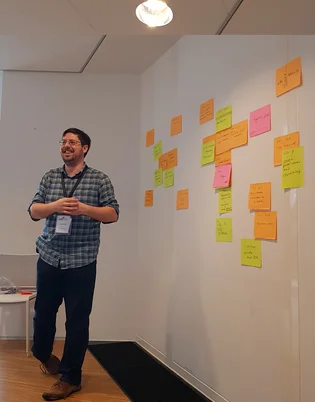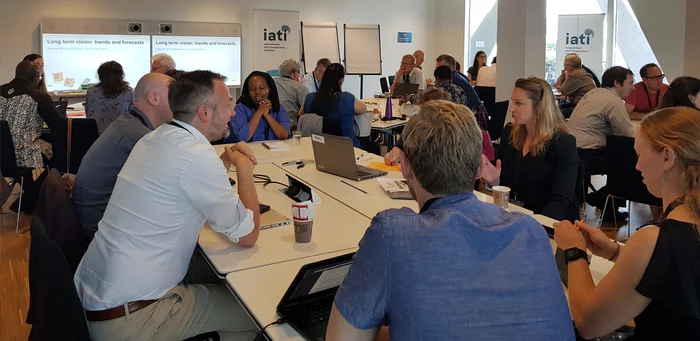IATI’s technical vision workshop 2019
This post was written by Wendy Thomas, IATI Technical Lead based at Development Initiatives.

Tim Davies facilitates IATI Technical Vision Workshop
UN City in Copenhagen was the setting for a focussed technical workshop to provide input into the technical vision for IATI for the next five years. Building on the previous steps in the Strategic Planning process (open consultations, data use survey, country case studies and member webinars), 30 representatives of IATI stakeholder groups gathered from 25-27 June for a deep dive into the Strategic Plan under the expert facilitation of Tim Davies.
IATI Strategic plan
The bulk of our sessions involved in-depth discussions on the long term vision for IATI, using the draft Strategic Plan to kick off discussions. We looked back, before we looked forward, using post-it notes to create an IATI timeline going right back to 2008, and then brainstormed what we wanted IATI to look like in 5 and 10 years.
Tim got us moving for the ‘Attitude Finder’ session, by having us stand around a statement outlining a future goal for IATI, and then asking people to move to one side of the room if they agreed and the other side if they disagreed. He then asked people to explain why they were standing where they were, which resulted in much shifting from one side to another. For example, there was an even split initially for the statement ‘In the future IATI needs to have a smaller core that everyone uses’. As people were asked to explain why they disagreed or agreed, more moved towards disagreeing. This session drove home the point of how important it is to discuss and listen to others!
We spent a few sessions discussing the future of IATI’s community. We worked in pairs to discuss what makes a good community, mapped out what we think the community is and should be and discussed how it could change and improve in future. At the end we jointly worked on a ‘Rough Guide to IATI Collaboration Cultures,’ describing all the various ways that people involved in IATI work with one another.
Technical sessions
Although the focus of this meeting was input into the IATI Strategic Plan, when you get a bunch of technical experts in a room, you have to provide space for technical discussions as well. The second morning of the workshop featured an update on last year’s Technical Audit, a presentation by suppliers of our forthcoming new Datastore and Validator, and a practical exercise on traceability.

Open spaces
Following ‘unconference’ principles the workshop also featured open spaces. They were un-themed agenda slots where delegates could ‘vote with their feet’ and suggest/attend sessions of interest. We had a wide array of spontaneous topics, including development of the Somali AIMS, defining the ‘core’ standard, reporting humanitarian data, the future of IATI’s Technical Advisory Group, guidance for IATI, user needs, improving the user experience…. And ‘Validation: a Love Story.’
Recommendations/what’s next
Participants’ inputs and thoughts were consolidated by master facilitator Tim as the last session took place. These inputs were fed back to the Secretariat and Board and considered in the next draft of the strategic plan. Key summary points stressed the need to:
- Understand and focus on user needs
- Improve data quality
- Improve the user experience
- Determine and agree the ‘core’ of the standard
- Consider the future configuration of the community
Underpinning these is the importance of language and meaning-- what do we mean by guidance, core, community?
Final thoughts
Thanks to all who came and gave their time, input and passion to the workshop. This was my first IATI event and I left energised and confident that IATI has a strong group of technical supporters who care very deeply about the Standard. I was also really pleased to see that gender balance at a technical meeting can be done! Last but not least, full marks to everyone who didn’t skip out of the sessions to join the hundreds of happy Danes swimming right outside our conference window.